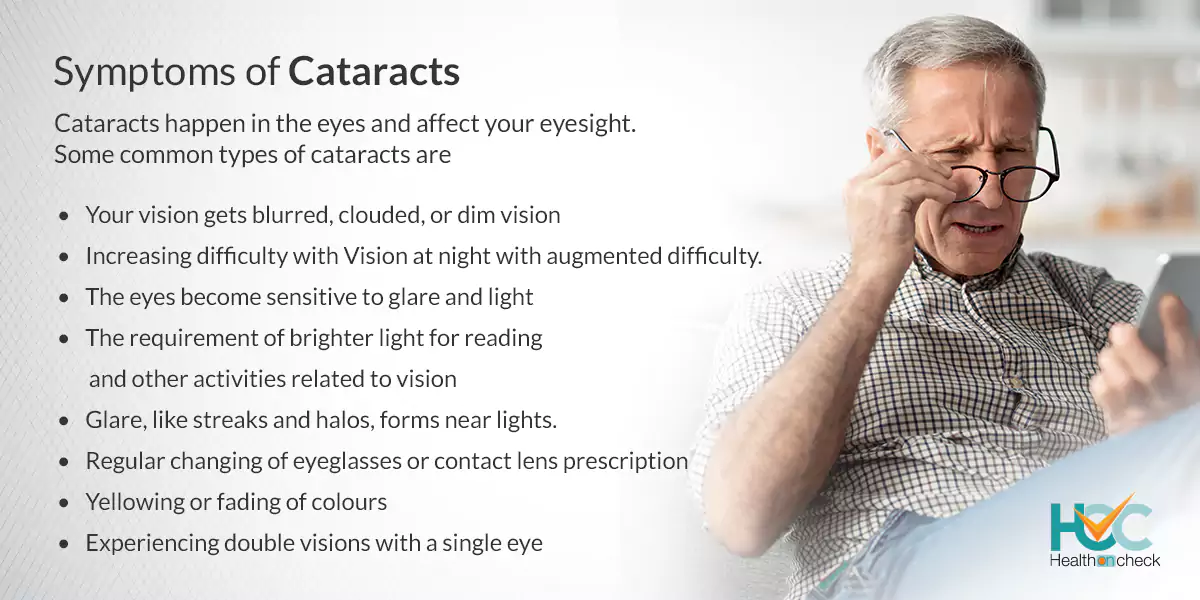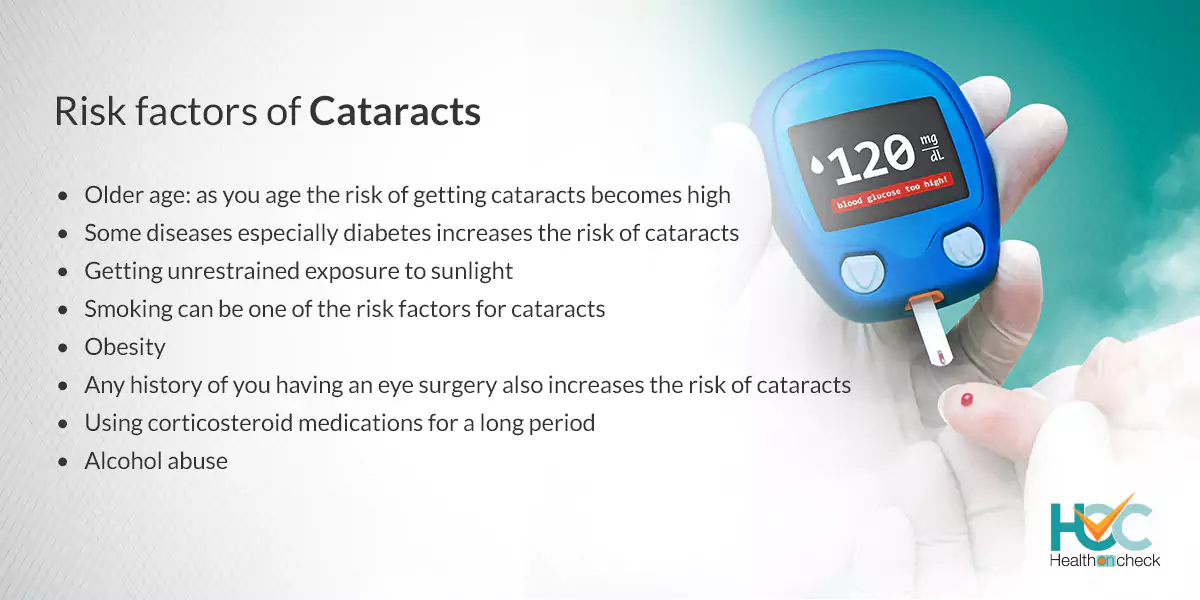All about Cataracts

What are Cataracts?
Cataracts basically are cloudy parts that shape the lens of the eyes. The lens of the eyes is a clear, adjustable structure that is made of proteins known as crystallins. As you age the proteins in your lens collapse, and cause cloudy patches affecting your vision. Cataracts develop leisurely and in starting the eyesight but as time passes, your eyesight gets affected. Cataracts are an unavoidable part of aging, and cataracts that are age-related are the most usual form of this disorder.
What are the Types of Cataracts?
There are numerous types of cataracts and they are classified on the basis of how and where they developed..
Nuclear Cataracts: It occurs in the middle part of the lens and makes the nucleus, or the center, become brown or yellow.
Pediatric Cataracts: Children and babies are mostly affected by pediatric cataracts. A baby might get born with cataracts or may occur sometime post-birth. Pediatric cataracts are mostly genetic but they may happen because of injuries or other eye-related disorders. Babies born with this type of cataracts need immediate treatment to avert problems such as amblyopia which is also known as lazy eyes
Cortical Cataracts: This type of cataract is wedge-shaped and occurs mostly adjacent to the edges of the nucleus.
Secondary Cataracts: This type of cataract usually happens because of medications or certain types of diseases. Glaucoma and diabetes are diseases that are connected with its growth.. Using medicines such as steroid prednisone and a few others can cause secondary cataracts.
Traumatic Cataracts: It mostly occurs because of an injury to the eye, but it can take many years for this to develop.
Radiation Cataracts: It develops when someone with cancer goes through radiation treatment
Posterior Sub Capsular Cataracts: It develops in the posterior cortex which means the backside of your lens. The backside of the lens is closest to the retina. The meaning “Subcapsular” is when the cataract occurs at the outer edge of the cortex, underneath the lens capsule.
Congenital Cataracts: This type of cataract mostly develops during a baby’s first year and is less common than cataracts which are age-related.
What are the Symptoms of Cataracts?

Cataracts happen in the eyes and affect your eyesight. Some common types of cataracts are
- Your vision gets blurred, clouded, or dim vision
- Increasing difficulty with Vision at night with augmented difficulty.
- The eyes become sensitive to glare and light
- The requirement of brighter light for reading and other activities related to vision
- Glare, like streaks and halos, forms near lights.
- Regular changing of eyeglasses or contact lens prescription
- Yellowing or fading of colours
- Experiencing double visions with a single eye
What are the Causes of Cataracts?
Cataracts mostly occur because of a restrained breakdown of proteins in your lens. Though environmental and genetic factors surge the chance of getting cataracts or sometimes it develops at a young age because of a family history of cataracts or an injury to the eyes. Cataracts are mostly cloudy lenses that are positioned behind the coloured segment of your eyes. The lens focuses light that passes through the eyes, which leads to transparent and sharp images on the retina.
With passing age, the lenses in your eyes get less flexible and transparent along with the eyes getting thicker.When cataracts start to develop, the clouding gets denser along with blocking and scattering the light when it goes through the lens, averting an acutely defined image to reach your retina and making your vision blurred.
Cataracts generally develop in both eyes, but not always at the same rate. The cataract in one eye may be more advanced than the other, causing a difference in vision between eyes.
What are the Risk Factors of Cataracts?

- Older age: as you age the risk of getting cataracts becomes high
- Some diseases especially diabetes increases the risk of cataracts
- Getting unrestrained exposure to sunlight
- Smoking can be one of the risk factors for cataracts
- Obesity
- Inflammation or any injury to the eyes increases the risk of getting cataracts
- Any history of you having an eye surgery also increases the risk of cataracts
- Using corticosteroid medications for a long period
- Alcohol abuse
What are the Complications of Cataracts?
The most dangerous complication of cataracts is that if it remains untreated then you may get completely blind. Cataracts can be treated only with surgery and the complications of cataracts occur mostly after cataract surgery including:
Infection: While going through surgery to cure cataracts, some germs may enter your eyes which can cause infection in the eyes. Your eyes may become sensitive to light or pain in the eyes along with problems in eyesight along with eyes becoming red. Antibiotics help to prevent infections post-surgery
Inflammation: The eyes getting swollen or redness is usual after cataract surgery but if it’s persistent, your doctor may prescribe eye drops or some medicines to stop them.
Retinal Detachment: The retina is placed in the back of the eyes and its main function is to sense light and send information to the brain. Post-surgery, there is a slight chance that it pulls away from the back of the eye.
Lens Fragments: During the surgery cloudy lens is removed but a few pieces might fall into the eyes and some are left behind. It may cause swelling in the eyes.
Build-up of Fluids in the Retina: At times after cataract surgery, blood vessels in the retina may leak and fluid up may happen which can blur your eyesight.
Eyes becoming Sensitive to Light: Even though the eyes becoming sensitive to light is very common after a surgery but sometimes it can happen for a long time and in such cases consult your doctor
How Cataracts Can be Diagnosed?
Reviewing your medical history and symptoms, and examining your eyes are the first steps to detecting cataracts and after that, you may have to go through some tests including:
Visual acuity test: An eye chart is used to measure how fine you can read letters. The letters will be kept at some distance from you and vary in size. The condition of both of your eyes will be checked and if one eye is closed then the other eye will be closed. It helps to detect if you have 20/20 vision or if your eyesight shows symptoms of eye-related problems.
Slit-lamp examination: During this test the doctor will check the structures inside the eyes through magnification through a microscope known as a slit lamp which uses an exceptional line of light, to light up your lens, cornea, iris, and the gap between your iris and cornea. It helps your doctor to examine them in small sections, making it simple to find any small abnormalities.
Retinal exam: During the retinal exam, drops in your eyes will be put to open your dilate and widen your pupils making it simpler to examine your retina. A slit lamp or a special device called an ophthalmoscope is used to check your lens for signs and symptoms of a cataract.
Applanation tonometry: It measures the fluid pressure of your eyes. There are various devices available for doing this test.
What are the Treatment Options Available for Cataracts?
There are no medications or other ways available to treat cataracts and cataract surgery is the only option available to get rid of cataracts and make your vision clear again. While going through cataract surgery, an ophthalmologist (cataract surgery specialist) will get rid of the clouded natural lens and restore it with an intraocular lens (IOL). An intraocular lens is an artificial lens that will be permanently attached to your eyes. There are various options available for an intraocular lens (IOL) and before the surgery, the ophthalmologist will discuss what is best suitable for you.
An IOL will be the same as your natural lens shall be. Some more advantage of it is that it can treat refractive errors, which will make you less dependent on glasses or contact lenses after your surgery.
Living with Cataracts
People with cataracts will mostly face problems such as nighttime vision problems like halos, glare, along with starbursts near the lights. Cataracts make life less radiant, in every literal sense. Colours will become faded and dull with a yellowish tint. Your view of the world will become like a musty, sepia-toned photograph. There is no way to treat it except cataract surgery which will extract cataracts and make your vision fine again.
Whom to Consult?
If you experience any changes in your vision and eyesight consult a doctor. Problems such as sudden changes in vision changes, double vision or flashes of light, unwarranted eye pain, or headache, meet your doctor as soon as possible after which he will diagnose your problem and if it’s a cataract then he will advise you to go for a cataract surgery, the only way to treat cataracts.




